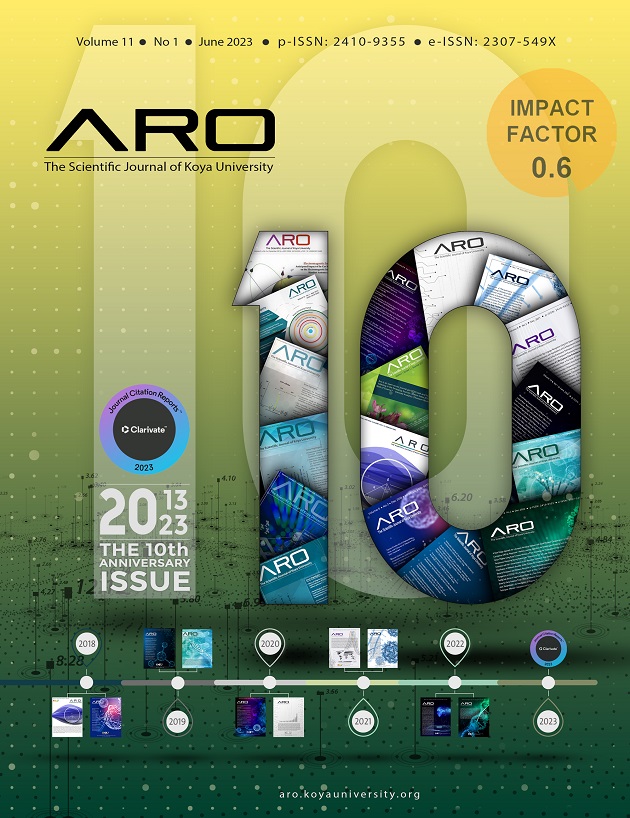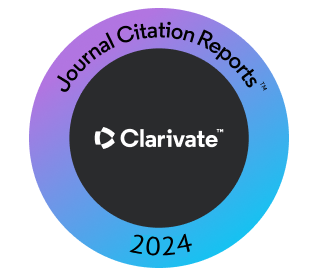The Most Common Characteristics of Fragile Video Watermarking
A Review
DOI:
https://doi.org/10.14500/aro.11113Keywords:
Fragile watermarking, Video watermarking, Tamper detection, Security, InvisibilityAbstract
The progress of network and multimedia technologies has been phenomenal during the previous two decades. Unauthorized users will be able to copy, retransmit, modify reproduction, and upload the contents more easily as a result of this innovation. Malicious attackers are quite concerned about the development and widespread use of digital video. Digital watermarking technology gives solutions to the aforementioned problems. Watermarking methods can alleviate these issues by embedding a secret watermark in the original host data, allowing the genuine user or file owner to identify any manipulation. In this study, lots of papers have been analyzed and studied carefully, in the period 2011–2022. The historical basis of the subject should not be forgotten so studying old research will give a clear idea of the topic. To aid future researchers in this subject, we give a review of fragile watermarking approaches and some related papers presented in recent years. This paper presents a comparison of many relevant works in this field based on some of the outcomes and improvements gained in these studies, which focuses on the common characteristics that increase the effect of watermarking techniques such as invisibility, tamper detection, recovery, and security
Downloads
References
Agarwal, H. and Husain, F. 2021. Development of payload capacity enhanced robust video watermarking scheme based on the symmetry of circle using lifting wavelet transform and SURF. Journal of Information Security and Applications, 59, p. 102846.
Ait Sadi, K., Guessoum, A., Bouridane, A. and Khelifi, F. 2017. Content fragile watermarking for H.264/AVC video authentication. International Journal of Electronics, 104, pp. 673-691.
Akhtar, N., Saddique, M., Asghar, K., Bajwa, U.I., Hussain, M. and Habib, Z. 2022. Digital video tampering detection and localization: Review, representations, challenges and algorithm. Mathematics, 10, p. 168.
Al-Otum, H.M. and Ellubani, A.A.A. 2022. Secure and effective color image tampering detection and self restoration using a dual watermarking approach. Optik, 262, p. 169280.
Aminuddin, A. and Ernawan, F. 2022. AuSR1: Authentication and self-recovery using a new image inpainting technique with LSB shifting in fragile image watermarking. Journal of King Saud University-Computer and Information Sciences, 34, pp. 5822-5840.
Begum, M. and Uddin, M.S. 2020. Digital image watermarking techniques: A review. Information, 11, p. 110.
Bhattacharya, A. and Palit, S. 2018. Blind quality assessment of image and video based on fragile watermarking and robust features. Multidimensional Systems and Signal Processing, 29, pp. 1679-1709.
Di Martino, F. and Sessa, S. 2012. Fragile watermarking tamper detection with images compressed by fuzzy transform. Information Sciences, 195, pp. 62-90.
El Gamal, A., Mosa, N. and El Said, W. 2013. A fragile video watermarking algorithm for content authentication based on block mean and modulation factor. International Journal of Computer Applications, 80, pp. 21-28.
Elrowayati, A.A., Alrshah, M.A., Abdullah, M.F.L. and Latip, R. 2020. Hevc watermarking techniques for authentication and copyright applications: Challenges and opportunities. IEEE Access, 8, pp. 114172-114189.
Gutub, A.A.A. 2022. Adopting counting-based secret-sharing for e-Video Watermarking allowing Fractional Invalidation. Multimedia Tools and Applications, 81, pp. 9527-9547.
Hammami, A., Ben Hamida, A. and Ben Amar, C. 2021. Blind semi-fragile watermarking scheme for video authentication in video surveillance context. Multimedia Tools and Applications, 80, pp. 7479-7513.
Hammami, A., Hamida, A.B., Amar, C.B. and Nicolas, H. 2020a. Regions based semi-fragile watermarking scheme for video authentication. Journal of WSCG, 28, pp. 96-104.
Hammami, A., Hamida, A.B., Nicolas, H. and Amar, C.B. 2020b. Regions based semi-fragile watermarking scheme for video authentication. In: International Conference in Central Europe on Computer Graphics, Visualization and Computer Vision, pp. 96-104.
Hassan, N.F. and Abbas, R.N. 2018. Proposed video watermarking algorithm based on edge or corner regions. Engineering and Technology Journal, 36, 25-32.
Li, C., Yang, Y., Liu, K. and Tian, L. 2020a. A semi-fragile video watermarking algorithm based on H. 264/AVC. Wireless Communications and Mobile Computing, 2020, p. 8848553.
Li, C., Yang, Y., Liu, K. and Tian, L. 2020b. A semi-fragile video watermarking algorithm based on H. 264/AVC. Wireless Communications and Mobile Computing, 2020, p. 8848553.
Makhrib, Z.F. and Karim, A.A. 2022. Improved fragile watermarking technique using modified LBP operator. In: 2022 International Conference on Computer Science and Software Engineering (CSASE). IEEE, United States, pp. 132-137.
Munir, R. 2019. A secure fragile video watermarking algorithm for content authentication based on arnold CAT map. In: 2019 4th International Conference on Information Technology (InCIT). IEEE, United States, pp. 32-37.
Munir, R. and Harlili, H. 2020. Application of chaos-based fragile watermarking to authenticate digital video. In: Digital Forensic Science. IntechOpen, London.
Munir, R. and Harlili, H. 2019. Authentication of Digital Video Using Fragile Watermarking Algorithm Based on Chaotic Map.
Patil, R.D. and Metkar, S. 2015. Fragile video watermarking for tampering detection and localization. In: 2015 International Conference on Advances in Computing, Communications and Informatics (ICACCI). IEEE, United States. pp. 1661-1666.
Rahma, A.M., Abdulmunim, M.E. and Al-Janabi, R.J. 2016. New Watermark Algorithm support Based on Watermark Designing. Diyala Journal For Pure Science, 12, 1-11.
Rakhmawati, L., Wirawan, W. and Suwadi, S. 2019. A recent survey of self embedding fragile watermarking scheme for image authentication with recovery capability. EURASIP Journal on Image and Video Processing, 2019, pp. 1-22.
Shukla, A., Gupta, A., Jaglan, S. and Shivani, S. 2022. An efficient self embedding fragile watermarking scheme based on neighborhood relationship. In: Innovations in Computational Intelligence and Computer Vision. Springer, Germany.
Wang, C., Shan, R. and Zhou, X. 2018a. Anti-HEVC recompression video watermarking algorithm based on the all phase biorthogonal transform and SVD. IETE Technical Review, 35, pp. 42-58.
Wang, C., Zhang, H. and Zhou, X. 2018b. Review on self-embedding fragile watermarking for image authentication and self-recovery. Journal of Information Processing Systems, 14, pp. 510-522.
Yu, X., Wang, C. and Zhou, X. 2018. A survey on robust video watermarking algorithms for copyright protection. Applied Sciences, 8, p. 1891.
Yu, X., Wang, C. and Zhou, X. 2019. A hybrid transforms-based robust video zero-watermarking algorithm for resisting high efficiency video coding compression. IEEE Access, 7, pp. 115708-115724.
Zhi-Yu, H. and Xiang-Hong, T. 2011, Integrity authentication scheme of color video based on the fragile watermarking. In: 2011 International Conference on Electronics, Communications and Control (ICECC). IEEE, United States, pp. 4354-4358.
Zhou, L., Zuo, M.J., Shi, H., Zhang, Y. and Gong, L.H. 2022. Robust watermarking algorithm against the geometric attacks based on non-subsampled shearlet transform and Harris-Laplace detector. Security and Communication Networks, 2022, p. 7605595.
Zigomitros, A., Papageorgiou, A. and Patsakis, C. 2012. Social network content management through watermarking. In: 2012 IEEE 11th International Conference on Trust, Security and Privacy in Computing and Communications. IEEE, United States, pp. 1381-1386.
Downloads
Published
How to Cite
Issue
Section
License
Authors who choose to publish their work with Aro agree to the following terms:
-
Authors retain the copyright to their work and grant the journal the right of first publication. The work is simultaneously licensed under a Creative Commons Attribution License [CC BY-NC-SA 4.0]. This license allows others to share the work with an acknowledgement of the work's authorship and initial publication in this journal.
-
Authors have the freedom to enter into separate agreements for the non-exclusive distribution of the journal's published version of the work. This includes options such as posting it to an institutional repository or publishing it in a book, as long as proper acknowledgement is given to its initial publication in this journal.
-
Authors are encouraged to share and post their work online, including in institutional repositories or on their personal websites, both prior to and during the submission process. This practice can lead to productive exchanges and increase the visibility and citation of the published work.
By agreeing to these terms, authors acknowledge the importance of open access and the benefits it brings to the scholarly community.
Accepted 2023-03-25
Published 2023-04-03
















 ARO Journal is a scientific, peer-reviewed, periodical, and diamond OAJ that has no APC or ASC.
ARO Journal is a scientific, peer-reviewed, periodical, and diamond OAJ that has no APC or ASC.